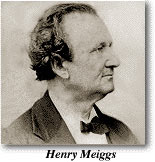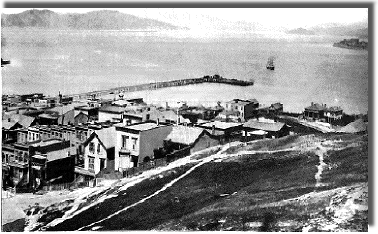The Wharf that Transformed the Life of Henry
Meiggs
 Henry Meiggs was one of the biggest "hustlers" in San Francisco
during the early '50's, a pioneer promoter of his day. He didn't
overlook anything, and like most men of his day and generation he
made his word good. He was forever pushing some enterprise. When
he landed in the city in 1850 all the vessels entering the Golden Gate
anchored in Yerba Buena cove at the foot of what was then
Washington, Commerical and Jackson streets. Wharves were
extended into the bay water there, and residents generally
recognized that locality as the city's only shipping point. Harry
Meiggs had other ideas. A year or two later he boomed North Beach
and built a road around the base of Telegraph Hill to Clarke's Point
on the north shore, where he had invested a pot of money in real
estate.
He ran out a wharf 2,000 feet long from the foot of Powell
Street, graded and extended the streets in that quarter, and started
a real estate boom. His object was to induce ship owners to make
use of his facilities for their warehouses. He urged that his dock
was closer to the Golden Gate, and its inducements superior to the
old anchorage. He plunged heavily into debt trying to swing this big
scheme. Henry Meiggs was one of the biggest "hustlers" in San Francisco
during the early '50's, a pioneer promoter of his day. He didn't
overlook anything, and like most men of his day and generation he
made his word good. He was forever pushing some enterprise. When
he landed in the city in 1850 all the vessels entering the Golden Gate
anchored in Yerba Buena cove at the foot of what was then
Washington, Commerical and Jackson streets. Wharves were
extended into the bay water there, and residents generally
recognized that locality as the city's only shipping point. Harry
Meiggs had other ideas. A year or two later he boomed North Beach
and built a road around the base of Telegraph Hill to Clarke's Point
on the north shore, where he had invested a pot of money in real
estate.
He ran out a wharf 2,000 feet long from the foot of Powell
Street, graded and extended the streets in that quarter, and started
a real estate boom. His object was to induce ship owners to make
use of his facilities for their warehouses. He urged that his dock
was closer to the Golden Gate, and its inducements superior to the
old anchorage. He plunged heavily into debt trying to swing this big
scheme.
 Meiggs knew every game being played in the city, political, social,
financial and otherwise. At that time street work was paid for in
warrants on the public treasury, signed by the Mayor and Controller.
The Controller had fallen into the easy habit of signing entire books
of blank warrants, and the Mayor, being a good fellow, followed suit.
Meiggs knew their system and though a pliable subordinate got
possession of one of these books properly signed for issue. Meiggs knew every game being played in the city, political, social,
financial and otherwise. At that time street work was paid for in
warrants on the public treasury, signed by the Mayor and Controller.
The Controller had fallen into the easy habit of signing entire books
of blank warrants, and the Mayor, being a good fellow, followed suit.
Meiggs knew their system and though a pliable subordinate got
possession of one of these books properly signed for issue.
There was no money in the street fund at the time, but that did not
disconcert Meiggs. He knew that the money lenders of the town
would bite at them, not knowing the situation, a sharp commentary
on the way the city business was conducted. Before any one had an
inkling, Meiggs had scattered enough warrants among money lenders
to raise his monthly interest to $30,000. Meiggs was safely in flight
when the storm broke. How much money he carried to Valparaiso,
Chili, was never discovered. Meiggs later declared that he landed
with only $8,000. He lost this in speculation, and had to pawn his
watch.
South America at that period proved a gold mine for a man of
Meiggs' irrepressible and resourceful character. Eventually he
accumulated a fortune estimated at $100,000 by building railroads
in Peru and handling government contracts in adjacent countries.
From his earnings he paid back every cent he owed his creditors in
California. Eventually he made overtures to return here, but failed.
San Francisco News Letter
December 5, 1925
Return to the top of the page.
|
 Henry Meiggs was one of the biggest "hustlers" in San Francisco
during the early '50's, a pioneer promoter of his day. He didn't
overlook anything, and like most men of his day and generation he
made his word good. He was forever pushing some enterprise. When
he landed in the city in 1850 all the vessels entering the Golden Gate
anchored in Yerba Buena cove at the foot of what was then
Washington, Commerical and Jackson streets. Wharves were
extended into the bay water there, and residents generally
recognized that locality as the city's only shipping point. Harry
Meiggs had other ideas. A year or two later he boomed North Beach
and built a road around the base of Telegraph Hill to Clarke's Point
on the north shore, where he had invested a pot of money in real
estate.
He ran out a wharf 2,000 feet long from the foot of Powell
Street, graded and extended the streets in that quarter, and started
a real estate boom. His object was to induce ship owners to make
use of his facilities for their warehouses. He urged that his dock
was closer to the Golden Gate, and its inducements superior to the
old anchorage. He plunged heavily into debt trying to swing this big
scheme.
Henry Meiggs was one of the biggest "hustlers" in San Francisco
during the early '50's, a pioneer promoter of his day. He didn't
overlook anything, and like most men of his day and generation he
made his word good. He was forever pushing some enterprise. When
he landed in the city in 1850 all the vessels entering the Golden Gate
anchored in Yerba Buena cove at the foot of what was then
Washington, Commerical and Jackson streets. Wharves were
extended into the bay water there, and residents generally
recognized that locality as the city's only shipping point. Harry
Meiggs had other ideas. A year or two later he boomed North Beach
and built a road around the base of Telegraph Hill to Clarke's Point
on the north shore, where he had invested a pot of money in real
estate.
He ran out a wharf 2,000 feet long from the foot of Powell
Street, graded and extended the streets in that quarter, and started
a real estate boom. His object was to induce ship owners to make
use of his facilities for their warehouses. He urged that his dock
was closer to the Golden Gate, and its inducements superior to the
old anchorage. He plunged heavily into debt trying to swing this big
scheme.